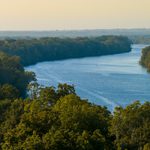
On June 19th, or Juneteenth, the Equal Justice Initiative (EJI) will celebrate the opening of the Freedom Monument Sculpture Park, its latest museum in Montgomery, Alabama. The 17-acre site displays contemporary artworks, first-person narratives, and historical artifacts which tell the stories about the more than 10 million Black people who were enslaved in the United States. Visitors to the park will embark on a unique narrative journey that explores the nation’s history of enslavement and its enduring legacy.
“I believe this will become a special place for millions of people who want to reckon with the history of slavery and honor the lives of people who endured tremendous hardship but still found ways to love in the midst of sorrow,” said EJI director Bryan Stevenson. “Many of us are the heirs to that extraordinary perseverance and hope. There is a lot to learn at this site and we want everyone to experience it.”


A core feature of the park is the National Monument to Freedom; standing nearly four stories tall, the monument lists 122,000 surnames of nearly five million Black people listed in the 1870 U.S. Census. “There’s a narrative of triumph that we need to acknowledge and the monument is a gesture toward that, as a physical space but also as a way of naming names, making personal, making human this history,” Mr. Stevenson told the Guardian. Interactive features at the site allow visitors to trace surnames geographically and genealogically, providing descendants an opportunity to explore family histories. “For people who are descendants to come and see that name and have a tangible connection made to that legacy is important and necessary,” he explained.

(credit: Equal Justice Initiative /Human Pictures)
Following the path of trafficked enslaved people, visitors can choose to enter the park by boat, crossing the Alabama River. Visitors are first provided with a brief history of Indigenous peoples in America, and then will learn about the history of slavery, with sections of the park specifically covering the slave trade, laws pertaining to the practice, and acts of resistance. The park includes a mixture of historical artifacts, including 170-year-old plantation dwellings and a whipping post, recreations, and 48 sculptures by 27 artists, half of which are newly commissioned works. The Freedom Monument Sculpture Park is the latest addition to EJI’s existing legacy sites – the National Memorial for Peace and Justice and the Legacy Museum.


EJI’s New Freedom Monument Sculpture Park, Equal Justice Initiative, March 27, 2024; David Smith, ‘A narrative of triumph’: a powerful 17-acre site in Alabama remembers enslavement, The Guardian, March 19, 2024; Hilarie M. Sheets, Alabama Sculpture Park Aims to Look at Slavery Without Flinching, The New York Times, October 11, 2023;
Race
Jun 14, 2024


